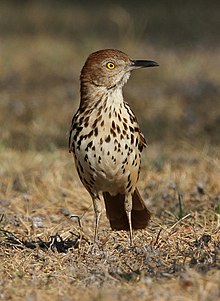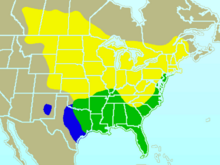Toxostoma rufum
| Brown thrasher | |
|---|---|
 |
|
| In Texas, USA | |
| Scientific classification | |
| Kingdom: | Animalia |
| Phylum: | Chordata |
| Subphylum: | Vertebrata |
| Class: | Aves |
| Order: | Passeriformes |
| Family: | Mimidae |
| Genus: | Toxostoma |
| Species: | T. rufum |
| Binomial name | |
|
Toxostoma rufum (Linnaeus, 1758) |
|
 |
|
| Range of T. rufum Breeding range Year-round range Wintering range | |
| Synonyms | |
The brown thrasher (Toxostoma rufum) is a bird in the family Mimidae, which also includes the New World catbirds and mockingbirds. The dispersal of the brown thrasher is abundant throughout the eastern and central United States, southern and central Canada, and is the only thrasher to live primarily east of the Rockies and central Texas. It is the state bird of Georgia.
As a member of the genus Toxostoma, the bird is a large-sized thrasher. It has brown upper parts with a white under part with dark streaks. Because of this, it is often confused with the smaller wood thrush (Hylocichla mustelina), among other species. The brown thrasher is noted for having over 1000 song types, and the largest song repertoire of birds. However, each note is usually repeated in two or three phrases.
The brown thrasher is an omnivore, with its diet ranging from insects to fruits and nuts. The usual nesting areas are shrubs, small trees, or at times on ground level. Brown thrashers are generally inconspicuous but territorial birds, especially when defending their nests, and will attack species as large as humans.
The brown thrasher was originally described by Linnaeus in his 18th century work Systema Naturae as Turdus rufus. The genus name Toxostoma comes from the Ancient Greek toxon, "bow" or "arch" and stoma, "mouth". The specific rufum is Latin for "red", but covers a wider range of hues than the English term.
Although not in the thrush family, this bird is sometimes erroneously called the brown thrush. The name misconception could be because the word thrasher is believed to derive from the word thrush. The naturalist Mark Catesby called it the fox-coloured thrush.
Genetic studies have found that the brown thrasher is most closely related to the long-billed and Cozumel thrashers (T. longirostre & guttatum), within the genus Toxostoma.
...
Wikipedia

